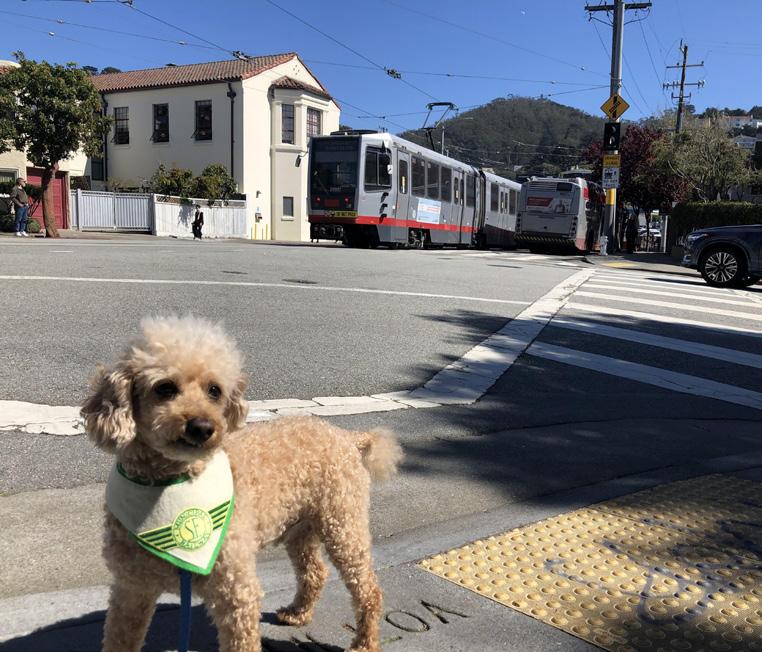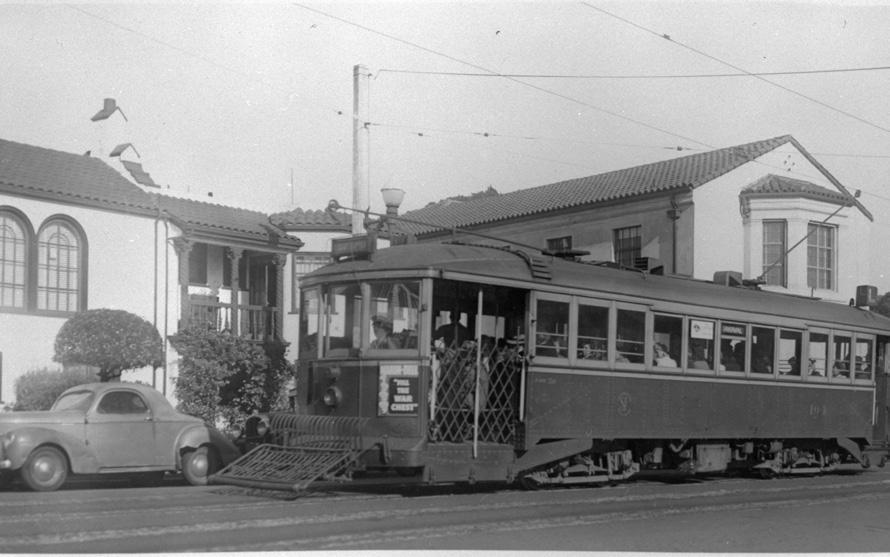
3 minute read
Where in West S.F.?
By Paul Judge
Our mystery photo of L streetcar #104 rolling westbound on Ulloa Street, with two emblematic landmarks – the West Portal branch library and a glimpse of the original Twin Peaks Tunnel entrance – set off a flurry of reader recollection. We’re talkin’ a veritable streetcar full of recognition and memories! This bunch could fill pages reminiscing about their rides and destinations aboard the L-Taraval.
Advertisement
Eagle-eyed and with Muni transfers in hand: Julie Alden, Fred Baumer, Frances Bruni, Tim Dineen, Roger Goldberg, David Green, Norm Stahl, Kathryn Wagner, and Wallace Wertsch.
Patricia Kennedy Shanahan noted the photo was likely taken during World War II because “it has a sign in front that says ‘Fill The War Chest.’” She further remarked that “today, Parkside residents wait for the ‘L bus’ heading West toward the Zoo at this location.”
Charlie opted for the 1950s era “Muni Wings” livery when crafting his bandana. (Courtesy of Margaret Ostermann) Ulloa Street near Lenox Way, circa 1944. (Jack Tillmany Collection; courtesy of a Private Collector / wnp67.0139)

Margie Whitnah responded: “As a young child, I remember those street cars, like that ‘L’ on Ulloa which went to the beach and zoo…I mostly rode the ‘K’ car from Ocean Avenue, which was two blocks from my house, mainly to go Downtown. For many of my earliest years, taking the streetcar Downtown with mom for shopping (before Stonestown was built) meant wearing white gloves and a nice dress, coat, maybe a hat, but most likely a colorful triangular head scarf tied under my chin, fog or not.”
Margie’s memories vividly recalled “those cross-hatched metal gates that were sort of scary to me…the clinging coin box, interesting ads above the seats, and, of course, the sound of the cord that those riders tall enough could pull to get off at the next streetcar stop. Sometimes, as riders, we’d have to ask for a flimsy piece of paper from the streetcar driver in order to transfer to another streetcar or bus. Often that was with my mom to transfer to the bus to visit my grandmother in the Sunset, Zita Puente. Neither she nor my mom ever learned to drive a car, or ‘The Machine’, as my grandmother called it, but in Spanish.” Before WWII, when streetcars were the more ubiquitous form of transit, “streetcar” was often shortened to “car,” while newfangled automobiles were colloquially called “machines.”
Junior historian Charlie put on his Muni kerchief to capture a present-day photo. But for Charlie’s human, Margaret Ostermann, it was the size of the cow catcher-like fender on the “Iron Monster” streetcar that proved totally fascinating. Some research revealed this to be an “eclipse fender,” designed “to actually scoop up pedestrians (after a good whack to the ankles!), preventing a fall beneath the streetcar. Looking at bustling street scenes from that era, I can only comfort myself in knowing that traffic moved a lot slower back then.”

7-line streetcar #162 on Market Street near 5th Street, August 5, 1946. (Courtesy of Jack Tillmany / wnp5.50650)
Margaret continued: “In reading up on this, I was struck by the fact that there were no traffic signals in San Francisco when Muni was founded in 1912. The first ‘traffic indicator’ was installed in 1915 at Market and Kearny. I hope more signals very quickly followed that first one, considering that the ‘roar of the four’ streetcar tracks down Market Street required pedestrians to cross through traffic to access the inner United Railroad lines. So yes, I can see the need for giant safety fenders back then! Although an ‘eclipse fender’ image search on OpenSFHistory reveals these fenders unintentionally provided a precarious perch to nip a ride when they were folded up on the rear end!”

Charlie caught a rare ride on Municipal Railway No. 1 – note the eclipse fender – on Muni Heritage Day, hosted by our friends at Market Street Railway. (Courtesy of Margaret Ostermann)
Hop off the streetcar with us to check out the next Where in West S.F.? mystery location.
Send your guesses to nicole@outsidelands.org








